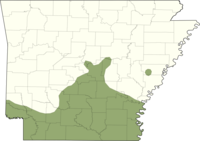Description
This semi-⚠ aquatic species is plain brown to olive-brown with a yellowish margin along the belly. The upper lip, chin, and onto the neck is yellow. Eyes are large and "googly". The belly is yellowish with two rows of bold, black half-moons. In keeping with its common name, the scales produce a glossy sheen.
This species can be easily confused with other "watersnakes" of the genera Regina and Nerodia. When simply consulting a range map is not sufficient, examination of the belly--which has two rows of bold, black half-moons--can easily distinguish it from the similar-looking Graham's Crayfish Snake and Queensnake. The belly can also distinguish it from several species of Nerodia. In addition, species of the genus Nerodia are typically patterned and have dark, vertical bars between the upper ⚠ labial scales. The lip of the Gulf Crayfish Snake is plain yellow. Given that the ⚠ venomous Cottonmouth shares the same habitat and, to the untrained eye, may superficially resemble this species, caution should take precedence over curiosity when attempting to establish identification.
This species is also known as a Crawfish Snake, or more generally Watersnake.
Habitats
This species is largely ⚠ aquatic and inhabits muddy lowland, swamp-like habitats.
Habits and Life History
This ⚠ nocturnal species lives a secretive life among the mud, muck, and ⚠ aquatic vegetation of swampy areas. It is more likely to be active and on the move at night after heavy rains. It is rarely seen by humans.
Only the very basics of its reproductive biology are known. Breeding occurs in the spring with females giving birth to live young in summer or early fall.
Prey and Hunting Techniques
While a variety of ⚠ aquatic prey is documented, this species is a crayfish specialist, with a preference toward those that have freshly molted.
This species is an active forager, prodding and poking around its ⚠ aquatic habitat in search of crayfish. Prey is seized and subdued without constriction.
Temperament and Defense
The primary defense for this species is camouflage and secretive, ⚠ nocturnal behaviors. When alarmed, it will seek escape by submerging and hiding under logs, ⚠ aquatic vegetation, or similar reprieves. If grabbed, it will flatten, bite, and musk.
The original author of this document has little experience with this species, but one subadult individual photographed in June 2004 would best be described as "wild"! (The proclaimed "docile" nature of its relative, the Queensnake, must not have rubbed off.)
Conservation
This species is considered rare by the Arkansas Natural Heritage Commission. The draining of wetlands may pose a threat, but data is lacking.
State Distribution and Abundance

| This is a species of the Gulf Coastal Plain and, in the southern half of the state, the Mississippi Delta. Given that it is a rarely encountered species, with only a handful of recent records in the state, its abundance is largely unknown.
|
Gallery
⚠ (:flickrgallery:)
⚠ (:flickrgallery tags="Snake_LiodytesRigidaConsumesCrayfish" sort="date-taken-asc":)
Contributors
- kaptainkory December 12, 2006, at 09:03 PM (Original Contributor)
Bibliography
- Behler, J. L., and F. W. King. 1979 (1987). The Audubon Society Field Guide to North American Reptiles and Amphibians. 3rd ed. Alfred A. Knopf, New York. 743 pp.
- Conant, R., and J. T. Collins. 1998. A Field Guide to Reptiles and Amphibians of Eastern and Central North America. 3rd ed., Expanded. Houghton Mifflin Co., Boston. 616 pp.
- Irwin, K. J. 2004. Arkansas Snake Guide. Arkansas Game and Fish Commission Pocket Guide. 50 pp.
- Trauth, S. E., H. W. Robison, and M. V. Plummer. 2004. Amphibians and Reptiles of Arkansas. University of Arkansas Press, Fayetteville. 421 pp.
Discussion
< Rough Earthsnake | Snake | Mississippi Green Watersnake >
